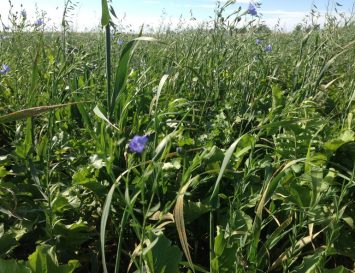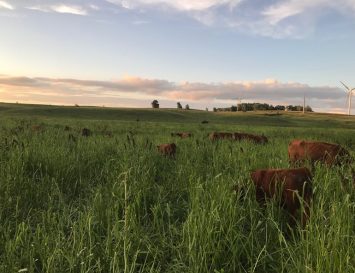Vernal Alfalfa
$2.70 - $2.85
Vernal alfalfa is one of the original lines of alfalfa genetics that has been around for many years. It is very drought and winter hardy. Vernal is best used for hay production on dryland or in alfalfa/grass mixtures to be hayed or grazed.
Seeding Rate:
Good Soil, Adequate Moisture: 15-20 lbs/acre
Light Soil, Dry conditions: 12-15 lbs/acre
Need some help? Contact us.
Product Guide
Planting
- Planting Time:
- Early Spring: After hard freezing conditions have ended
- Late Summer/Early Fall: Allow 4-6 weeks of growth before the first hard frost
- Seeding Rate:
- Good Soil, Adequate Moisture: 15-20 lbs/acre
- Light Soil, Dry conditions: 12-15 lbs/acre
- Ideal Seed Depth: ½”
- Alfalfa should be drilled into a firm seedbed or broadcasted and packed
Fertility
- Alfalfa requires 12 lbs of P2O5, 49 lbs of K2O, and 5.4 lbs of S per ton of forage.
- Make fertilizer applications based on expected yield and soil fertility levels.
- If soil fertility levels are low, applying 25-30 lbs/acre of nitrogen at planting will help increase stand establishment.
- Do not exceed a total of 10 lbs/acre of N+K if fertilizer is placed in-furrow at planting.
Weed Control
Plant into a clean, weed-free seed bed and use the herbicide options below for optimal weed control:
| Timing | Herbicide | Rate | Notes | Weeds Controlled | Control Method |
| Preplant Inc. or Preemergence | Eptam 7E (EPTC) | 2.25-4.50 pts/a | Apply and incorporate 2-3″ immediately after application and plant shortly after | Grasses & Broadleaves | Residual |
| Makaze (Glyphosate) | 1 qt/a | Apply any time before crop emergence | Grasses & Broadleaves | Contact | |
| Postemergence (seedling) | Butyrac 200 (2,4-DB) | 1-3 qts/a | Apply before weed heights exceed 3″ | Broadleaves | Contact |
| Pursuit (Imazethapyr) | 3-6 oz/a | Apply when seedling alfalfa is in the second trifoliate stage or larger | Broadleaves | Contact | |
| Poast (Sethoxydim) | 0.75-2.0 pts/a | Apply before weeds exceed 8″ in height | Grasses | Contact | |
| Select Max (Clethodim) | 9-16 oz/a | Apply before weeds exceed 8″ in height | Grasses | Contact | |
| Prowl H2O (Pendimethalin) | 1.1-2.1 pts/a | Apply after the 2nd trifoliate growth stage, but before the crop reaches 6″ in height | Grasses & Broadleaves | Residual | |
| Broclean (Bromoxynil) | 1.0-1.5 pts/a | Apply when alfalfa has a minimum of 4 fully developed trifoliates | Broadleaves | Contact | |
| Postemergence (established) | Butyrac 200 (2,4-DB) | 1-3 qts/a | Apply before weed heights exceed 3″ | Broadleaves | Contact |
| Pursuit (Imazethapyr) | 3-6 oz/a | Apply immediately after a cutting before excessive regrowth begins | Broadleaves | Contact | |
| Poast (Sethoxydim) | 0.75-2.0 pts/a | Apply before weeds exceed 8″ in height | Grasses | Contact | |
| Select Max (Clethodim) | 9-16 oz/a | Apply before weeds exceed 8″ in height | Grasses | Contact | |
| Prowl H2O (Pendimethalin) | 1.1-4.2 qts/a | Apply while crop is dormant, or after a cutting before crop reaches 6″ in regrowth | Grasses & Broadleaves | Residual |
*Always read and follow label instructions before making an application
Disclaimer: All products and rates were provided by university-based sources and product labels. Always follow label instructions and consult your local chemical dealer and seed dealer before making any applications or planting of seed.
Management
- Nurse Crops: Spring seeded alfalfa can be planted with a small grain nurse crop such as oats, barley, or spring triticale. Use 1/3 – ½ seeding rates of the nurse crop to avoid over competing with new alfalfa. Ex. 1 bushel of oats as a nurse crop vs. a full rate of 3 bushels.
- Nurse crops have little benefit to late summer/early fall seedings and are not recommended.
- Avoid pushing new alfalfa seedings too hard during the establishment year. 1-2 cuttings during the first year are acceptable, depending on growing conditions and region.
- Allow 3-4 weeks from the time of the last cutting until the average first frost date to allow alfalfa to regenerate reserves needed to survive winter and perform well the following year.
Multiple Regions
Every acre is different and our goal is to help you know what works best in your area. This 'Growing Regions' section showcases where this species works best. If you have any questions on product placement, feel free to contact our experts and we will help!















